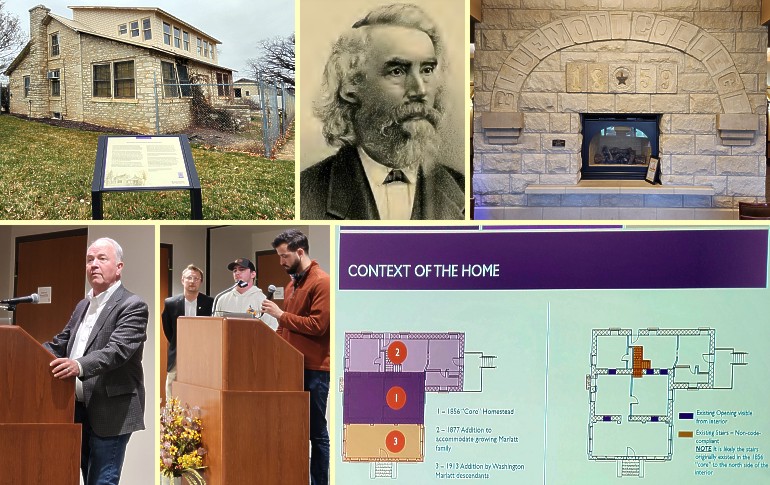Kansas Snapshots by Gloria Freeland - December 6, 2024
"Stirring up dust"
On November 19, husband Art and I had a "date" ... at the local library! It was just a week after my abdominal surgery, so I was
still sore and a bit unsteady on my feet. But one of my pet projects that I've been working on for 10 years was finally gaining
some traction and I wanted to be there to see it.
The project is the preservation of the homestead of Washington Marlatt, one of the founders of the forerunner of my alma mater. My
personal turning point was a response to an April 2015 email I sent to the Kansas State University archives. David Vail responded,
"We’ve pulled some materials that relate to Marlatt and his home. ..."
I was hooked!
Marlatt came here as one of the early advocates for Kansas being a free state and figured he'd do his part by serving as a Methodist
minister and then move on. But his education, combined with fate, placed a detour in his path.
He immediately became involved with the discussions about building a college in Manhattan. Bluemont Central College was to be
located on the northwest corner of the current-day intersection of Claflin Road and College Avenue. In 1856, Davies Wilson, a
surveyor and land speculator, had built a house just north and east of that location. Being a practical man, Marlatt figured it
would be nice to be able to walk to work, so he purchased Wilson's home in 1858. Made of local limestone, it's considered the
oldest standing stone residence in Riley County.
By 1859, Marlatt was the first principal of the institution. Julia Bailey was hired from the East in 1859 as an assistant teacher.
They married in the college building in 1861, the same year Kansas became a state.
In 1863, the school became Kansas State Agricultural College, the nation's first operational land-grant school. In 1875, the campus
moved a mile and a half south and east, so Marlatt’s home is today on the western fringe of the university, just south of K-State
Athletics' soccer facility.
When the Bluemont building was torn down, Marlatt purchased some of the materials to build a barn on his property. He placed the
carved stone blocks with the words "BLUEMONT COLLEGE" over the barn's west entrance. They are now located above the fireplace at the
K-State Alumni Center.
Marlatt eventually left the university to return to his calling as a minister. He and Julia raised a family, supporting themselves
by farming. The homestead was later purchased by K-State.
The historical significance of the property has never been questioned as it is on the Register of Historic Kansas Places. But no one
has been able to figure out just what to do with it. So for years, the property has been used as a storage area.
Patricia O'Brien, a professor of archaeology and sociology at K-State, had done research on the property and proposed a museum to
highlight K-State's land-grant history. I loved her proposal, but, alas, museums don't typically make a lot of money and funding the
preservation and re-imagining of the house, barn, and outbuildings will take significant cash.
While I have a passion for this sort of thing, that's about the extent of what I can contribute. I'm neither a preservation expert,
nor have I done any significant fund-raising. Art had a friend who was fond of saying that his role in many projects was "stirring up
dust." It was his way of saying that sometimes your job is to just keep making noise and hope you get the attention of people who
can do more.
Over the years, a task force formed. It has now morphed from a loosely-connected group that wanted to prevent further damage to the
property to a dynamic committee that has come up with ideas for its adaptive re-use. It now includes a restoration specialist,
museum staff members, Manhattan/Riley County Preservation members, professors in rural studies, anthropology and architecture,
and me.
Ray Yunk, professor in architectural engineering and construction science, "took the ball and ran with it" - assembling an
interdisciplinary team of K-State students and professors to assess and provide preservation guidance for the home, barn, and site.
He arranged for the home to be 3D-scanned, a technology that allows a structure to be converted into design drawings.
So what was the meeting at the library? Five student members of the team - Hannah McCormick, Chris Marble, Devin Holliday, Rodrigo
Sanchez, and Kate Lennon - presented various proposals for use of the property. These included: making the home into a
bed-and-breakfast for alumni, guest lecturers, and athletic recruits and their families; re-purposing the barn into a venue for
alumni reunions, tailgate parties, and other events; creating an interpretive landscape, utilizing native plants.
It was inspiring to hear the ideas of those talented young people. They will now have to be vetted by professionals in their fields
and then reduced to formal renderings before fund-raising efforts can begin.
It's still a long way to the finish line, but I and the others who have been and are involved are optimistic. And I'll keep doing
what I do best ... connecting people by stirring up dust.
